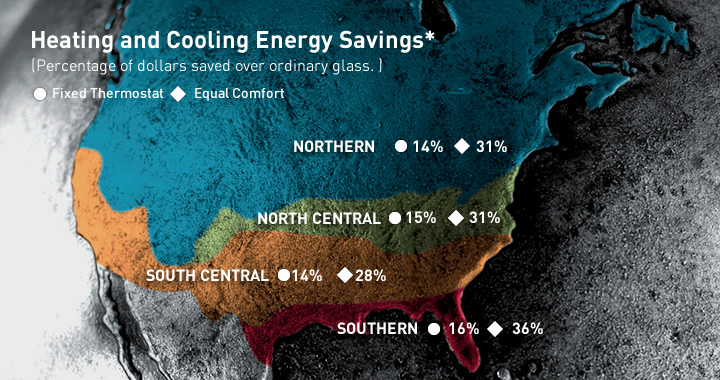Save energy with glass so smart, it can control your comfort.
Although windows provide beautiful views and wonderful natural light, they can also account for up to 50% of the heating and cooling energy consumed in a home. In the summer, EnviroGuard LoĒ²-270 windows keep your home cool and comfortable by rejecting the sun’s heat and damaging rays. In the winter it helps your home stay warm and cozy by blocking heat loss to the cold weather outside. In short, it can save energy year around.

* Thermostat settings are the largest variable in establishing the heating and cooling energy savings potential with window replacements. If you tolerate the discomfort from your current windows and don’t change thermostat settings with the weather, consider the savings suggested from the “Fixed Thermostat” column. If on the other hand you frequently adjust the thermostat, add space heaters to compensate for cold rooms, or close drapes/blinds to block the sun consider the additional savings suggested in the “Equal Comfort” column.
Heat/Cool portion of your energy bill: DOE estimates that in 2005 the average house spent $2,003 on utilities and that 43% of this total ($886) is for heating and cooling energy. (http://buildingsdatabook.eren.doe.gov/TableView.aspx?table=2.3.10). Savings values are average of multiple locations within climate zone. “Average” house as described in the Buildings Data Book at http://buildingsdatabook.eren.doe.gov/TableView.aspx?table=2.2.7 The model house is described as a mid-1970’s single-story dwelling with natural gas furnace, central air-conditioning, adequate insulation, and double-pane windows. Window orientation set as uniformly distributed on all sides to represent a neighborhood average and the total window area set to 15% of the floor area. Interior shading devices are presumed to be closed 50% of the time throughout the year. “Fixed Thermostat” conditions are 70°F for heating and 75°F for cooling. “Equal Comfort” thermostat settings determined using window thermal comfort research from the University of California at Berkeley (http://www.cbe.berkeley.edu/research/pdf_files/SR_NFRC2006_FinalReport.pdf). The existing double-pane windows used heat/cool thermostat setpoints of 72°F/74°F to match the comfort of LoĒ²-270 glass at 70°F/78°F. House heat/cool energy simulations used the Resfen program from Lawrence Berkeley National Lab (http://windows.lbl.gov/software/resfen/resfen.html).
